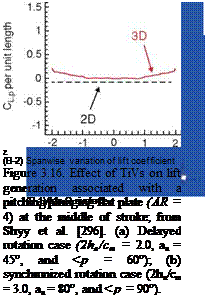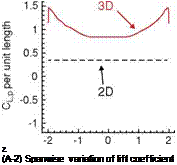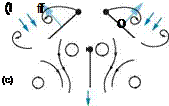Tip Vortices (TiVs)
Tip vortices (TiVs) associated with fixed finite wings are seen to decrease lift and induce drag [297]. However, in unsteady flows, TiVs can influence the total force exerted on the wing in three ways: (i) by creating a low-pressure area near the wingtip [296], (ii) through an interaction between the LEV and the TiV [296], and (iii) constructing a wake structure by downward and radial movement of the root vortex and TiV [298]. The first two mechanisms (see Fig. 3.15) also were observed for impulsively started flat plates normal to the motion with low aspect ratios: Ringuette et al. [299] presented experimentally that the TiVs contributed substantially to the overall plate force by interacting with the LEVs at Re = 3.0 x 103. Taira and Colonius [300] used the immersed boundary method to highlight the 3D separated flow and vortex dynamics for a number of low aspect ratio flat plates at different AoAs. At Reynolds numbers of 3.0 x 102 to 5.0 x 102, they showed that the TiVs could stabilize the flow and exhibited non-linear interaction with the shed vortices. Stronger
 |
 |
influence of the downwash from the TiVs resulted in reduced lift for lower aspect ratio plates.
For flapping motion in hover, however, depending on the specific kinematics, the TiVs could either promote or make little impact on the aerodynamics of a low aspect ratio flapping wing. Shyy et al. [296] demonstrated that for a flat plate with AR = 4 at Re = 64 with two different wing motions (such as delayed rotation and synchronized rotation; see Fig. 3.16), the TiV anchored the vortex shed from the leading edge, thereby increasing the lift compared to a 2D computation under the same kinematics. In contrast, under different kinematics with a small AoA and synchronized rotation, the generation of TiVs was small, and the aerodynamic loading was well approximated by the analogous 2D computation. They concluded that the TiVs could either promote or make little impact on the aerodynamics of a low aspect ratio flapping wing by varying the kinematic motions [296]. Furthermore, at Re = 64, Trizila et al. [301] found that four prominent competing effects were in play due to TiVs:
1. Enhancement of lift due to the proximity of the associated low- pressure region
of the tip vortex next to the airfoil
 |
 |
Figure 3.17. Sectional schematic of wings approaching each other to clap (a-c) and fling apart (d-f), from Sane [312] and originally described in Weis-Fogh [68]. Black lines show flow lines and dark blue arrows show induced velocity. Light blue arrows show net forces acting on the airfoil. (a-c) Clap. As the wings approach each other dorsally (a), their leading edges touch initially (b), and the wing rotates around the leading edge. As the trailing edges approach each other, vorticity shed from the trailing edge rolls up in the form of stopping vortices (c), which dissipate into the wake. The leading-edge vortices also lose strength. The closing gap between the two wings pushes fluid out, giving an additional thrust. (d-f) Fling. The wings fling apart by rotating around the trailing edge (d). The leading edge translates away and fluid rushes in to fill the gap between the two wing sections, giving an initial boost in circulation around the wing system (e). (f) A leading edge vortex forms anew, but the trailing-edge starting vortices are mutually annihilated because they are of opposite circulation.
2. Induced downwash acting to reduce the effective AoA along the span and weakening the LEV, hence reducing the instantaneous lift
3. Interaction with the vortices shed from the LEs and TEs and anchoring them from shedding near the wingtips, thereby enhancing the lift
4. Because TiVs pull fluid from the underside of the wing to the upper side, the wing leaves behind a weaker pocket of downward momentum in the flow. On interaction with this downward momentum, a loss in lift is seen, and so a weaker wake valley means higher lift.











